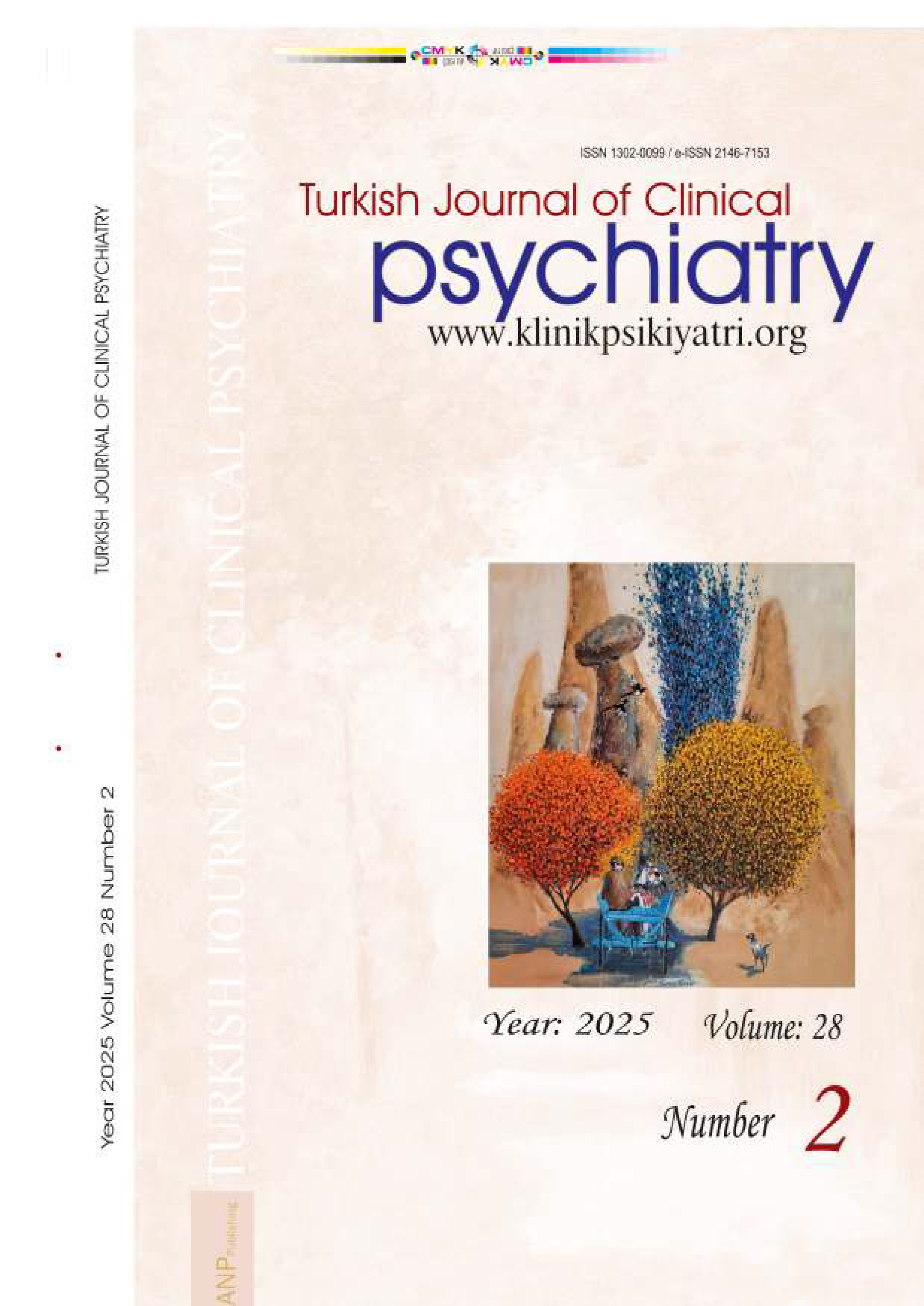





Volume: 8 Issue: 2 - 2005
| RESEARCH ARTICLE | |
| 1. | The Role of Traumatic Life Events on Forming Axis-1 Disorders in Comorbid Panic Disorder Mustafa Özkan, Şakir Özen, Nermin Ertunç Pages 53 - 59 Objective: In this study, we aimed to evaluate the role of traumatic life events on the comorbidity of axis-1 disorders onto panic disorders (PD). Method: A total of 115 patients (female 61%), who were consecutively diagnosed as PD at the psychiatry outpatient clinic were included into the study. Structured Clinical Interview for DSM-IV Axis I Disorders, Panic and Agoraphobia Scale (PAS), Life Events Scale (LES), Brief Physical and Sexual Abuse Inventory (BPSAI), Dissociative Experiences Scale (DES), State-Trait Anxiety Inventory (STAI-II) and Beck Depression Inventory (BDI) were performed to all patients. Results: Major depression was detected in 33% of patients, and in a total of 69% patients axis-1 comorbidity were found. In patients with axis-1 comorbidity; the number of negative life events was higher (p=0.009), but BPSAI and LES points did not change significantly (p>0.05). In 59 patients with agoraphobia BPSAI (p=0.024) and PAS (p<0.001) points were higher. The age of 33 patients with suicidal thoughts were younger (p=0.019); these patients had higher BPSAI points (p<0.001) while their PAS points did not change (p>0.05). Conclusion: There is no clear evidence that a specific trauma can lead to a specific psychiatric disorder. However, various traumatic events may accumulate in the course of time, force the subject's resistance and adaptation, and finally a psychiatric clinical picture will be formed depending on person's biopsychosocial features. The frequency of recent life events accounts for the occurrence of comorbidity onto PD. The traumatic events in childhood and adolescence are mostly associated with agoraphobia and suicidal thoughts rather than comorbidity. |
| 2. | Relationship Between Unlike Grow up Conditions and Alexithymia, Depression, Psychopathology Deniz Erden Pages 60 - 66 Objective: The aim of this study is to compare adolescents who grew up in orphanage with adolescents who grew up in their families in terms of alexithymia, depression and psychopathology. The second aim is to investigate relationship between alexithymia and depression, pyschopathology was determined for the both groups. Method: The research included n=30 adolescents who grew up in orphanage and n=30 adolescent who grew up in their families,ages between 17-18. For the evaluation purpose the Toronto Alexithymia scale ( TAS), Beck depression scale and SCL-90 R scale were administered. The data were analyzed using t- test for independent groups, pearson moments correlations, linear regression analysis. Results: Significant differences was found between alexithymia and depression mean score of the two groups. While there was a meaningful relationship at p<0.01 level between alexithmia and depression scores in the first group. This kind of relationship was not observed in adolescents group who grew up in their families. Depression variable was found to be significantly contributing to the prediction of alexithymia score in the first group. In term of psychopathology there was not a meaningful difference however the mean values were turned out to be higher for the both groups. In addition depression scores were found significant correlation with psychopathology for the two groups. Conclusion: Adolescents who grew up in orphanage are more alexithymic and depression than others. Depression has a close relationship to alexithymia in this group.There wasnt found relationship between alexithymia and psychopathology for both groups. |
| 3. | Psycho-oncology in the point of view of Oncology Doctors: Haldun Soygür, Elvan Özalp, Eylem Şahin Cankurtaran, Hüseyin Karşıgil, Gazanfer Özenci Pages 67 - 73 Objective: The goal of the study was to determine the level of information of the doctors on Consultation- Liaison Psychiatry (CLP) and psycho-oncology (PO) at the beginning of settling of a psychiatry clinic and two years later. Method: Two hundred and seventeen doctors working in the hospital were applied a questionnaire, which was prepared by us for obtaining information about the doctor's opinions on CLP and PO. The questionnaire was reapplied in the same way two years after. Doctors answered the questionnaire by choosing one of four options: "high", "moderate", "low", "any". Results: On first application, the rate of answering the questionnaire was 48.3%; after two years, the rate was higher than previous application (68.2%). The level of information on CLP and PO of the doctors increased in two years time (p=0.001). Doctors answered positively that psychiatrist have to be included in oncology team on the first application 50%, two years after 78%, (p=0.0001). The frequency of pscychiatric consultation ratios were 16% "high", 33% "moderate", 37% "low" ve 14% "any "after two years ratios were 25 % “high", 49% moderate,22% "low", 4% "any" (p=0.002). Conclusion: According to the results of questionnaire; doctors working in our hospital have been much more informed on CLP and PO in two years time, interested in much more about their patients' psychiatric complaints and they have frequently consultated their patients and especially explained that psychiatrists have to be included in oncology team. |
| REVIEW | |
| 4. | Public Health and Ethical Aspects of Psychostimulant Treatment in Children Şahbal Araş, Semih Şemin Pages 74 - 87 The debates over attention-deficit hyperactivity disorder (ADHD) in scientific literature and mass media mainly center concerns about the rising diagnosis and use of psychostimulants depending on ambiguous core symptoms (hyperactivity, attention deficit and impulsivity) of disorder. It is important that practices on management of this disorder should base on scientific evidences; they should consider ethical principles and target improving mental health of children. In this respect, it might be ethically acceptable that adequately qualified health professionals diagnose and treat this disease following a sufficient evaluation of the children and all the treatment choices without any conflict of interest. It is also important that all the children who need treatment should have access to the adequate treatment opportunity. By this way, treatment risk could be shared only by the children who really need treatment. The onset or exacerbation of symptoms of ADHD, presenting with these symptoms and the assessment or treatment process may be influenced by different sociocultural factors in diverse cultures. Since there is scarce information about such factors, there may be a limitation in developing appropriate treatment interventions in Turkey. However, there has been an increase in the rates of diagnosis of ADHD and psychostimulant medication treatment. In our country where education and health conditions are quite underdeveloped, it is unrealistic to expect solutions for all psychosocial problems in children from medicine. In Turkey, policies on education and health should be considered according to current scientific developments in ADHD management in the world and sociocultural characteristics of our country. |
| 5. | Attachment Process in Infancy: A Review A.Şebnem Soysalı, Şahin Bodur, Elvan İşeri, Selahattin Şenol Pages 88 - 99 Parents play a key role in the emotional development of infants. Attachment concept in infancy consists of many affectional and behavioral patterns of positive reactions to parents or primary caregivers, seeking and preference of them, sense of pleasure in the presence of primary caregivers. Attachment is the strong emotional bond that develops between infant and caregiver, providing the infant with emotional security. By the second half of the first year, infants have become attached to familiar people who have responded to their need for physical care and stimulation. How does attachment develop and which factors affect it? How is attachment security measured? These are all questions of great theoretical and practical interest that can be answered from diverse perspectives. The main cause of many psychopathologies in childhood and adolescence related to the quality of infant-caregiver relationship. Most of the pathologies in infancy require the improvement of this relationship for a successful treatment. Effect of pathological attachment process in infancy on future relationships is still a popular reseach topic todays. For this reason it is important to clarify the manner and dynamics of infant-care- giver relationship. In this review, related literature is overwieved in respect to attachment theory of Bolwby. Animal and human studies in the aspect of attachment, evaluation of attachment, attachment styles, patterns and process of attachment are discussed. |
| CASE REPORT | |
| 6. | Two Cases with Neurosyphilis Presenting in Various Clinical Manifestations Ahmet Tiryaki, Gökhan Kandemir, Evrim Aktepe, İsmail Ak Pages 100 - 104 Neurosyphilis can resemble virtually any psychiatric disorder, including depression, mania, psychosis, personality changes, delirium and dementia. Though neurosyphilis is infrequent today with early treatment, consequently a high index of suspicion and routine serologic screening of psychiatric and neurologic patients are needed. Because most manifestations of neurosyphilis are potentially reversible, it is vital that no case of the disease remain undiscovered or untreated. In this paper we report two cases with neurosyphilis which are presenting symptomatology of dementia and affective disorders. In former clinical evaluations both cases were misdiagnosed for thorough labarotary examinations were not accomplished. After treatment of neurosyphilis with penicillin, steady improvements were noted in cognitive and affective symptoms. These two cases emphasize the importance of considering neurosyphilis in differential diagnosis of patients with psychiatric symptoms. A complete history and physical and neurological examinations complemented by appropriate testing are essential. All psychiatric patients who are suspected for organic etiology should be screened for neurosyphilis with serum Veneral Disease Research Laboratory or Rapid Plasma Rreagin tests, and serum Fluorescent Treponemal Antibody - Absorption and spinal fluid studies should be obtained when neurosyphilis seems possible. |










